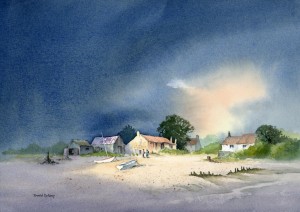Some of you asked if I would show the full image of the promontory watercolour published on the post on 5th May, so here it is – the scene is in the central Highlands of Scotland, easily seen from the roadside as you approach Rannoch Moor to the north.

As you can see, I’ve positioned the lightest part of the composition behind the row of Caledonian pines on the further promontory, to give them more emphasis. The more shadowy parts of the background mountains were achieved by washing a mixture of French ultramarine and cadmium red over those parts which had already been painted. This was done with a large wash brush and quite a weak mixture, creating a thin transparent glaze across those areas I wanted to subdue, and thus emphasising the light section.
The painting is part of the exhibition at the John Muir Trust centre in Pitlochry (Tel.01796 470080) which I should point out ends on the 11th June, not 18th as previously announced. This is due to a mix-up, and I hope no-one will be inconvenienced.
Next week Jenny and I will be at the annual Patchings Art Festival in Calverton, just north of Nottingham, where I’ll be demonstrating for St Cuthberts Mill on the mornings of Thursday 5th and Friday 6th June. St Cuthberts Mill make the marvellous Saunders Waterford and Bockingford papers that are such favourites with amateur and professional painters alike. Do come along and say hello.
On the 20th and 21st June Jenny and I will be demonstrating at the Sandpiper Studio on the Wirral in Cheshire. Jenny will be demonstrating pastel painting on the afternoon of Friday 20th and I shall be demonstrating in watercolour on the Saturday morning and giving an illustrated talk on how to rescue watercolours that have gone astray, after lunch. You can find out more about these events from Julie McLean on 07788 412480 or email her at: info@thesandpiperstudio.co.uk


